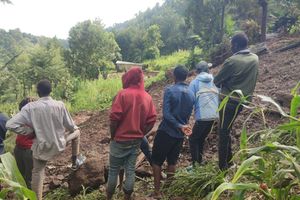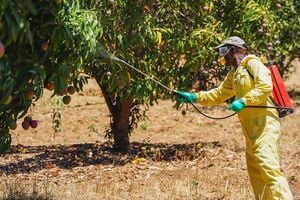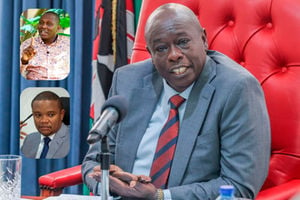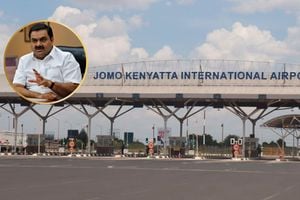Nyandarua banks on sh4.5 billion climate change action plan for food security and job creation
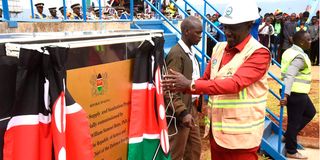
President William Ruto launch a Sh600,000 million water project in Ol Kalau, Nyandarua County on January 11, 2024.
What you need to know:
- Nyandarua is keen to capitalize on opportunities presented by climate change, prioritizing agriculture and renewable energy investments for job creation and wealth generation.
- The county projects to invest over Sh800 million and Sh1 billion, respectively, in the renewable energy and food security sectors.
Nyandarua County is leveraging a Sh4.5 billion Climate Change Action Plan to combat the adverse effects of climate change, enhance food security, and create jobs and investment opportunities. The initiative has already secured Sh104 million from the World Bank, having ranked 4th best in Climate Change resilience policies and commitments.
An additional Sh200 million is expected by March next year if the county maintains its climate change-related performance standards. The ambitious 2023-2027 Action Plan, tailored specifically for local communities, revolves around community-driven initiatives, with 25 ward climate change committees as the lead ambassadors, drawing on traditional knowledge of climate change and weather patterns, and how ancestors coped with similar challenges.
Successful implementation of key areas will also depend on cooperation with neighbouring counties—Laikipia, Nakuru, Nyeri, and Kiambu. Joint efforts will focus on ecosystem conservation and management, with ecotourism emerging as a shared interest.
Nyandarua is keen to capitalize on opportunities presented by climate change, prioritizing agriculture and renewable energy investments for job creation and wealth generation. The county projects to invest over Sh800 million and Sh1 billion, respectively, in the renewable energy and food security sectors. The food security sector under the five-year action plan covers livestock and crop production, drought and adverse weather mitigation, pest and disease control, and research.
“The Action Plan is about one year old, but we are encouraged and thank development partners, including the World Bank, under the Financing Locally-Led Climate Action program through the County Government Climate Change Unit (CGCU), which is keen on supporting our climate agenda.
The donor community is motivated by the county government’s commitment to actualize the Action Plan which is community-driven,” says Water, Environment, Climate Change, and Natural Resources CEC Mr Wachira Mugo. The document, which builds on weather patterns dating back to 1981, outlines eight objectives focused on food security, water scarcity, environmental conservation, climate change adaptation and mitigation, green energy, and resilient infrastructure.
“We’ve made significant strides since developing the document. Our biggest achievement is the enactment of the Nyandarua County Climate Change Act 2021, which establishes a climate change fund of at least 2 percent of the development budget. Thanks to Governor Kiarie’s intervention, we’ve been allocated 3 per cent in the current financial year—a fact that motivates donors to support us,” added Mr Wachira. He credits the early successes to a participatory process involving stakeholders eager to seize emerging climate change opportunities.
“The journey began with the development of the Participatory Climate Risk Assessment Report, which led to the Action Plan. Our team visited all 25 wards to gather input from community members, including farmers, vulnerable groups, and elders with indigenous knowledge, such as freedom fighters. All proposed activities came directly from the community. The County Climate Change Fund and World Bank funding have ensured sustained implementation,” explains Ms Njeri.
World Bank funding is directed to three specific sectors: agriculture, environment, and water. Under the environment sector, Nyandarua is implementing green energy programmes targeting learning institutions, homesteads, and vulnerable groups.
“We are encouraging the culture of environment conservation and embracing renewable energy right from the schools, where it’s a win-win situation. For instance, the schools are supported to start livestock keeping, grow crops, and serve as livestock farming resource centres for small-holder farmers whilst using biogas for fuel and lighting the schools,” says Ms Njeri.
Mr. Mwanzia Kyambia, the climate change director at the county noted that boreholes, both collapsed and newly constructed, are being fitted with solar panels to reduce water production and supply costs.
“Some boreholes collapsed because the community and government couldn’t afford electricity bills, sometimes as high as Sh400,000 every month. With solar energy, boreholes can now pump water day and night, allowing residents to engage in small-scale farming,” said Mr Mwanzia.
At Njabini-Ngwataniro in Kinangop Constituency, a water intake serving four wards—Engineer, Gathara, Githioro, and Njabini—is undergoing a Sh19 million expansion under the water security sector. Additionally, a treatment unit at the Ex-Major dam in Ol Kalou is included in the current financial year, with plans for drip irrigation and beekeeping for the surrounding community.
“The Ex-Major dam is also undergoing Sh19 million rehabilitation and expansion. It’s a highly integrated project funded by the World Bank. The bank officials have visited and approved the feasibility study. Given its highland location, the dam will be a game-changer, supporting fish farming, beekeeping, food production, and clean water for domestic use. It will serve parts of Ol Kalou and Ol Joro Orok Constituencies,” said Mr Mugo.
Ex-Jacob, one of the largest colonial dams, sits on 50 acres of land.

